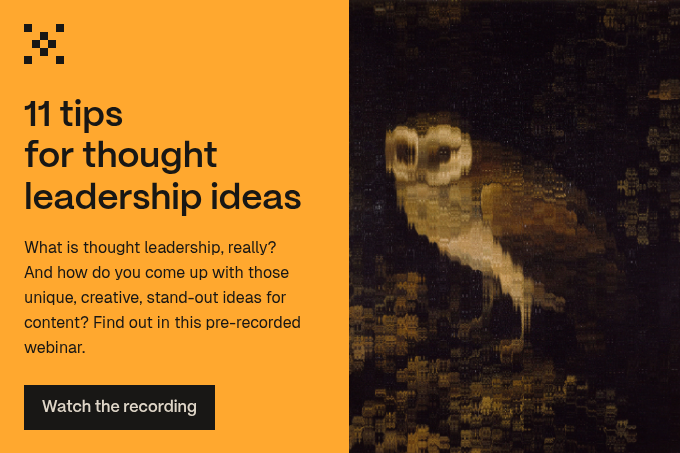The first step to good B2B tech content writing is to avoid bad writing altogether.
Alright, alright. I hear you saying ‘Well, that’s easier said than done’ – and you’re right. It is easier said than done.
Whatever job you're in, we're all writers in some capacity, but some of us underestimate the importance of writing and overestimate our own ability. Particularly, in the case of B2B tech writing, writers may verge off the beaten track and go into too much technical detail, as opposed to writing something of use to their customers. Every form of content has its pitfalls. And, without good writing, your entire content strategy will under-perform.
But, trust us on this one: good writing can be learned. And we’re here to show you how.
Firstly, let’s take a look at how to recognise bad writing.
Understanding bad B2B tech content writing
Here’s a quick run down of the seven types of bad writing:
- It thinks too much of itself. Private Eye runs a regular column lampooning the abuse of the word ‘solution.’ For example, Dow Corning’s 'Innovative solutions for wound management', which means 'bandages'. This kind of word inflation devalues meaning and encourages the scepticism of readers.
- It’s clever by half. Some people are afraid to write how they speak. They want to sound big, grown-up and clever. But this doesn’t make for good content. Say what you need to say simply and shortly, and you’ll find that it’ll be more readable.
- It’s too hyped up. Buzzwords can make readers over-discount your claims. Your automation software might be good, but is it really ‘cutting-edge’? What’s more, too many adjectives can make a sentence hard to read.
- It tells lies. Your readers will never trust your authenticity as a tech agency unless you tell the truth. Make sure your B2B tech content writing contains good research, accurate reporting and details.
- It ignores the reader. Bad B2B tech content writing ignores what the reader wants to hear, instead favouring what the writer wants to say. You’re not writing for you. You’re writing to help and educate your target buyer personas.
- It has no direction. If your writing doesn’t have a purpose, your readers will lose track and interest. Similarly, if you have more than one direction, they’ll get confused.
So, there’s your quick list of things to spot in bad B2B tech writing… But, what makes a piece of content good? If you want to know how to start a blog, well, that's vital info. Thankfully, we have some answers:
Creating good B2B tech content writing
Although the subject matter may be matter-of-fact, your B2B tech content writing is being written for humans, so make sure it caters for them.
You might be discussing a topic as interesting as the top new AI implementations for businesses, but your content won’t be readable unless you write it in an accessible way. Even an interesting topic can be ruined by a bad write-up.
Here are some tips for writing in a way that’s both human and enticing:
- Write conversationally. You can recreate a conversation in prose by changing the way you write. So, avoid the passive, use occasional colloquialisms, and stick to everyday abbreviations (such as ‘don’t’).
- Picture your target persona. As a B2B tech agency, your ideal buyer persona might be anyone from a CEO to an office administrator. It’s important to imagine writing your content for that specific person. Consider what interests them or what their pain-points might be.
- Interview yourself. Okay, yes, this might seem a bit odd. But if you picture yourself explaining your chosen topic to someone else, it’ll help you to put down your thoughts in a broken-down, easily digestible way.
- Use short sentences. Conversation is rarely made up of paragraphs. It’s short and snappy; it’s consumable. Write like you talk and your readers will listen. (Or, well, read.)
- Find power in short words. You might think it’s smarter to use complex words. But, unless you’re Stephen Fry, it’ll make your writing seem forced. So, use ‘get’ instead of ‘acquire’, ‘choose’ rather than ‘select’ etc. etc.
- Cut the jargon. We know, we know. When writing about tech, it can be all too tempting to use marketing speak such as ‘cutting-edge’ or ‘ground-breaking’. But these are over-the-top and not at all how you’d talk to your customers face-to-face.
- Break the rules. If it makes the writing better, you can start sentences with ‘but’, ‘so’, ‘because’ and ‘and’. Finish sentences with a preposition and split infinitives. Because, why not? Experimenting is fun. Boldly go, and all that.
- Inject some humour. Humour and politics separate us from other animals. Use it. Just be funny.
- Embrace the exclamation mark (occasionally). Yes, it can become a bit too jarring to use them all the time. But if you want to sound like a real person, give it a try. Go for it!
- Use everyday metaphors. Particularly for hard-to-grasp technological concepts and products, it can sometimes be better to ground your writing in familiar things. Compare a complex problem with something relatable.
Writing for readability
Readability measures how easy your text is to read. Not everyone reads at a university level. In fact, if you want your copy to be read and understood by the ‘general public’, the rule of thumb is to write for a reading age of 12 or 13, even for technical articles.
With that in mind, here are some tips to help you create readable content:
- Avoid speed bumps. Symbols such as ‘&’ and ‘%’ are speed bumps for the eyes. Instead, replace them with the word alternatives (‘and’ and ‘percent’).
- Don’t over-capitalise. Some technology companies are guilty of over-capitalising important nouns unnecessarily, such as Cloud technology.
- Get rid of needless tech acronyms. Unless they’re commonplace, like ‘PC’, you might want to make sure you explain any more complex acronyms (‘PaaS’, for example).
- Cut the passive voice. Your brain has to work harder to process a passive sentence.
- Avoid long words, sentences and paragraphs. Try to steer clear of complicated words; subordinate clauses; sub-sentences in brackets, or run-on sentences separated by colons or semi-colons (like this one!). Similarly, short paragraphs and bullet lists will help your readers to understand the structure of your tech content better.
- Proofread! Spelling and grammatical mistakes trip the reader up and force them to substitute the correct words.
The second component of readability is more positive. It comprises the techniques used to make writing memorable, credible and compelling. For B2B tech writing, these quick tips will get you on the road to good copy:
- Avoiding anything that switches off readers: unsubstantiated claims, jargon and hype
- Using strong verbs, good analogies and pithy quotations
- Eliminating clichés and ‘waffle’
- Inserting credible data from the real world
- Avoiding buzzwords, such as: ‘deliverables’, ‘drill down’, ‘proactive’ and ‘traction'
- Citing believable authorities – such as Microsoft or Gartner
- Creating well-written introductions, titles and subheads
- Making the first and last sentence of each paragraph especially clear
If you require some help in making your tech content more readable, it may be useful to measure the readability statistics of your writing. Certain tools, such as Hemingway Editor, can help you distinguish where you can improve your work.
Be patient and practice
Learning to write good B2B tech content comes with practice. The more you write, the more it’ll feel like second nature. Equally, the more you read, the more you’ll understand what’s smooth and what isn’t.
So, are you ready to get writing? Yes? Well, what are you waiting for? Start working on your first draft - we're waiting to read what you have to say!






